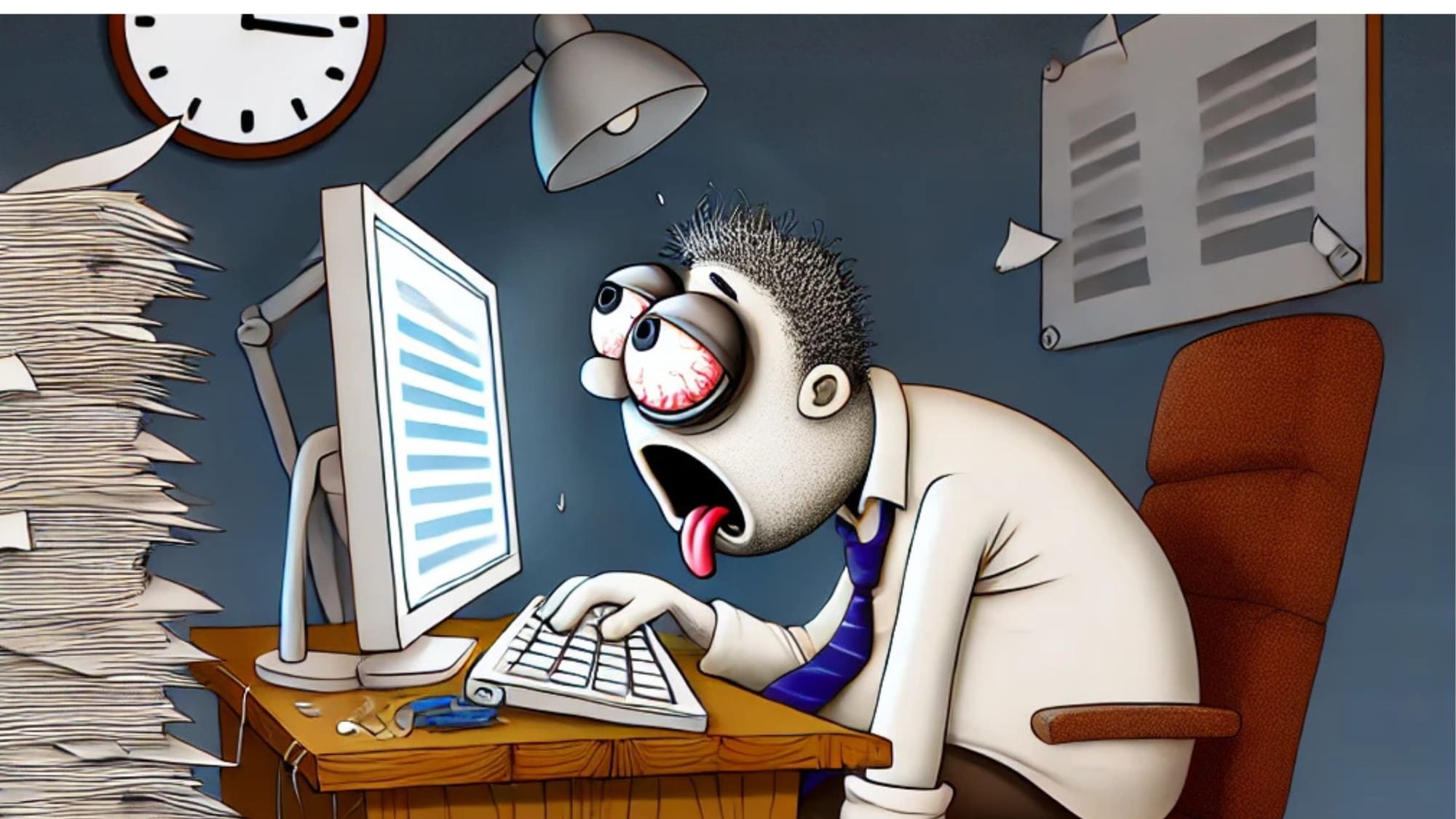Trapped in the Office Grind: A Day in the Life of a Stressed-Out Worker
Trapped in a work routine that drains your energy and dims your dreams? Discover the cycle of a day in the life of a worn-out office worker—and why breaking free might be the best decision yet.
Why do some of us end up choosing a work life that seems to drain our health and well-being?
The answer to this question often becomes clear only in hindsight. We’re here because we have bills to pay, responsibilities to manage, and maybe a family to support. For many, this applies across industries where we’ve built a routine and adapted to the nature of our work.
Perhaps we trained or studied specifically for the role we’re now in, aiming for what once seemed like a dream job. But now, that dream has blurred into a monotonous, high-pressure environment, where the daily grind is unchanging, and the organization we work for seems just as stagnant. Sure, there’s a paycheck waiting at the end of every month, but it can start to feel like our entire existence has been reduced to simply getting by.
It’s as though the professional path we thought would bring us fulfilment has somehow turned into a trap, locking us into a cycle we can’t see a way out of.
If the day below sounds familiar, it might be time to start thinking about finding an exit.

7:00 am – Wake-Up Call
The alarm blares, yanking you out of precious sleep. You hit snooze twice, finally pulling yourself out of bed, wishing you had just a few more hours.
7:15 am – A Quick Breakfast (Or Is It?)
You pour some cereal or pop a slice of bread in the toaster. Breakfast is minimal, and coffee is a must. The thoughts of the workday start creeping in, making you a bit queasy before you even take the first bite.
7:30 am – Pre-Work Anxiety
As you get ready, nervous anticipation sets in. Mentally scanning through what awaits: a mountain of emails, meetings with no end, and tasks that seem to stretch endlessly, the weight of the day feels crushing before it even begins.
8:30 am – The Commute Rush
In the usual rush, you leave home slightly later than planned. After a near-miss with public transport or a hurried drive, you arrive at work just on time. There’s a small victory here—but you’re already tired.
9:00 am – Quick Hellos and Zero Chit-Chat
You give a polite nod or a quick “morning” to colleagues, avoiding much more conversation. Time’s tight, and there’s too much on your plate to linger by the coffee machine.
9:05 am – The Overwhelming Sight of Emails and Meetings
You turn on your computer, greeted by unread emails and back-to-back meetings booked for nearly every hour. The anxiety returns, stronger now, as you mentally brace yourself for the marathon of the day ahead.
9:30 am – The First Meeting
You’re physically present in the first meeting but mentally, you’re tackling your inbox. While others are talking, you scan email subjects, attempting to prioritise responses but struggling to fully focus on either.
10:15 am – Vending Machine Comfort Run
Needing a break, you escape to the vending machine and splurge on snacks: crisps, chocolate, maybe even a cake. These little treats are a quick comfort, even if they’re adding up financially and nutritionally.
12:30 pm – Skipped Lunch
By midday, you realize you’re not even hungry after all those snacks. Skipping lunch seems like a good way to save time, so you keep pushing through emails, hoping to make a dent in your inbox.
2:00 pm – Meeting Fatigue and Reluctant Contributions
As the day wears on, you’re called on in meetings. You know you should contribute, but the fear of taking on more work holds you back. Instead, you respond minimally, hoping to avoid extra tasks.
4:00 pm – Email Battle Continues
Despite hours of effort, you’ve only skimmed the surface of your inbox. The unread messages just keep piling up, adding to the mental exhaustion. You wonder if you’ll ever catch up.
6:15 pm – Late Departure and Missed Train
You finally leave the office, later than intended, just as you see the train pulling away. Resigned to your luck, you wait for the next one, exhausted and dreaming of home.
7:00 pm – A Quick Dinner
At home, too tired to cook, you grab a microwave meal and a soft drink, eating in front of the TV. It’s not exactly gourmet, but it fills the gap and requires no energy—your main priority at this point.
8:00 pm – Numbed Out on TV
The TV is on, but you’re barely watching. The exhaustion sinks in, and before you know it, you’re dozing off, head dropping forward as the screen lights up the room.
10:30 pm – The Long Trek to Bed
Groggy, you head to bed, but sleep doesn’t come easily. The stress of the day lingers, thoughts spinning about what was left undone and the challenges waiting for tomorrow.
3:00 am – Restless Sleep
After hours of tossing and turning, you finally drift off around 3 am, but it’s far from restful. The cycle continues, and soon enough, it’ll be time to start again.
If this day is you then it's time to review your options.

1. Review Your Daily Agenda
Instead of feeling overwhelmed by the chaos of your workload, take a proactive approach by planning and prioritising. Identify which tasks are essential and deserve your focus.
If your inbox is overflowing, ask yourself why: can some emails be filtered or delegated? Are you only included "for your attention" in some, or are there meetings you don’t need to attend?
By sorting through the clutter, you can zero in on tasks that truly need your attention. Talk to your line manager if your workload feels unmanageable, and don’t hesitate to escalate the issue if needed. Don’t suffer in silence.
2. Take a Lunch Break and Eat Healthy
Your lunch break is essential—treat it like a non-negotiable task. Step outside, get some fresh air, and find a change of scenery, ideally where there’s nature. Use this time to clear your mind and recharge.
Pack a nutritious lunch, even if it means picking up food on your way home or during your morning commute. Include healthy options like fruits, vegetables, and plenty of water. Eating well and taking time for yourself can improve your overall mood and energy, helping you wind down for a restful night’s sleep.
3. Request a More Flexible or Hybrid Work Model
Do you need to be in the office every day? Times have changed, and many organisations offer remote or hybrid work options. If the daily commute and rigid office routine are wearing you down, request one or two work-from-home days to break up the week.
If your manager is hesitant, reach out to HR for support. A hybrid schedule can provide much-needed variety and a break from the monotony.
4. Practice Saying No
Sometimes, you simply need to say no. Assess your workload realistically and communicate honestly with others about what’s on your plate. If taking on a new project or task is unfeasible, politely decline and explain why.
Setting yourself up to not be a pushover ensures you don’t become the go-to person for everyone else’s extra work, helping you focus on your priorities.
5. Plan an Exit Strategy
If you’ve realized your workplace is a toxic environment that won’t change despite your efforts, it might be time to consider moving on. Start reviewing job listings and applications in the evenings, crafting a solid resume and cover letter. Ensure your LinkedIn profile highlights your skills and experience.
Finding the right role may take time, but having a well-thought-out plan will give you a sense of control and help you feel more optimistic about the future.
You got this.
Goodluck!







